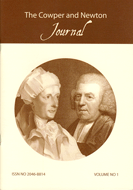Brian Lynch is an Irish poet and scriptwriter: this is his first novel. It is a richly textured,
tragi-comic exploration of the life of William Cowper, a fellow-poet with whom he clearly
feels a deep affinity. He insists that it is not a biography, but it would be fair to classify it as
‘fictionalised biography’, a genre which has become firmly established in recent times
through the practice of writers such as Peter Ackroyd and Julian Barnes. Indeed, Brian Lynch
has remained significantly more faithful to the known facts surrounding his subject than have
some other authors in the field. There is evidence on every page of his intimate knowledge of
Cowper’s letters and poems, and of the work of earlier biographers such as Lord David Cecil
and James King. He has closely researched the poet’s milieu, and presents a convincing
picture, not only of the lives of William Cowper, John and Mary Newton, Mary Unwin and
the other dramatis personae of the story, but of life in Olney and the surrounding countryside.
But he does far more than this. Above all, he brings a poet’s eye to the narrative and
structure of the book. Naturally, for a poet writing about a poet, questions of technique arise
and are discussed at appropriate points in the story. There is a beautiful chapter in which
Newton and Cowper visit a lacemaking school, on the way discussing the finer points of
hymn-writing. At the school, Cowper is deeply moved by the pathos of the little girls
working in freezing conditions, but also inspired by the power of simple verses, the
lacemakers’ ‘tells’, to imprint themselves on the memory – which in turn feeds back into the
continuing discussion of hymn writing. But the poetic method informs the book in more
subtle and important ways – through imagery especially, but also through wordplay and a
vivid particularity in the realisation of people and objects. For example, the poem ‘The
Snail’, which is seen as clearly autobiographical, provides a recurring motif illuminating
aspects of Cowper’s character and, in particular, his sexuality. The prevalence of wordplay is
such that the reader must be ever on her toes if she is not to miss some of the subtleties of
what is on offer. There is a mystery at the heart of the book – the meaning of ‘Sadwin’ –
which is partially unravelled by discussions of the names of the characters, but which
demands an alertness to the nuances of language which is as bracing as a Norfolk sea breeze.
The novel deals with large themes – madness, love, loneliness, creativity, old age – as
played out amongst a group of people living in a small market town at a time of major social
and political change. As in Jane Austen’s work, irruptions from the wider world of revolution
and the French wars unsettle the apparently uneventful lives of the protagonists. Cowper and
Mary Unwin, however, with the Newtons, constitute an inner circle which dangerous or
interfering outsiders like Anna Austen and Harriot Hesketh attempt to penetrate in vain.
Exclusion is a powerful force prompting action and forming character: exclusion of
interlopers from the inner circle, Cowper’s feelings of exclusion at school because ‘he is not
like other boys’, exclusion by death from his mother’s love, culminating, tragically, in the
unshakeable belief in his exclusion from God’s love. Morally, all the characters can be selfish
and manipulative, not least the saintly Mary Unwin when her stake in Cowper is challenged,
but a measure of ordinary human kindness is enough to create lasting bonds between true
friends and enable them to survive (‘All four of them had loved each other’, p.320).
As is appropriate for a hero who lived most of his life in an intimate female circle
(there is a recurring image of Cowper as Hercules ‘unmanned’ when he became the servant
of the queen Omphale), the women are given their full due. The character of Mary Unwin is
explored with great delicacy as a person with her own foibles, weaknesses and jealousies as
well as a heroic capacity for devotion. It is good to see the balance thus partially restored
between William, who through his letters and poems was able to fashion his own image for
posterity, and Mary, who has left scarcely any record of her real character and emotions. John
and Mary Newton are painted with a broader brush and seem not quite fully realised, but the
most challenging creation is Lady Austen, who imparts a heavy sexuality and vitality to the
central chapters and then is cast off as brutally as was Falstaff by Prince Hal. Others have
their exits and their entrances – Theadora, his first love, the Revd. Bull, who weeps at every
mention of Christ’s suffering, Johnny Johnson, birdlike saviour and carer for the old couple,
and the appalling Samuel Teedon, whose frowstiness is evoked with a relish worthy of
Dickens.
The Winner of Sorrow is a vividly imagined exploration of the life and inner struggles
of a complex personality – it gives us a Cowper for our times. It is a demanding read, but
worth the effort for the fresh insights it brings to our understanding of the man and the forces
which shaped his poetry.
[The Winner of Sorrow (paperback, 352 pages) was first published by New Island,
Dublin, in 2005; copies are available on Amazon, or as a 2009 reprint by Dalkey
Archive Press.]

